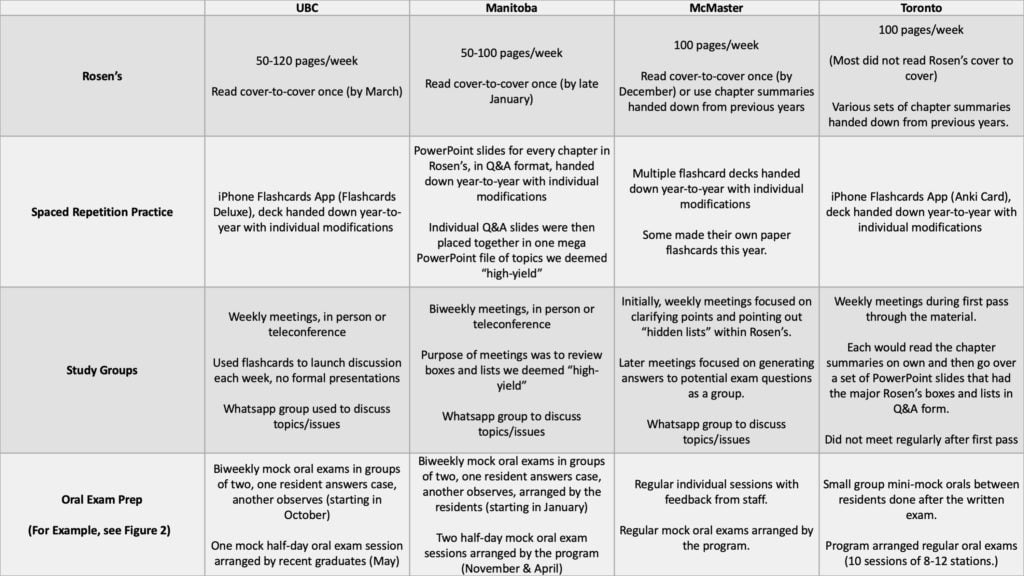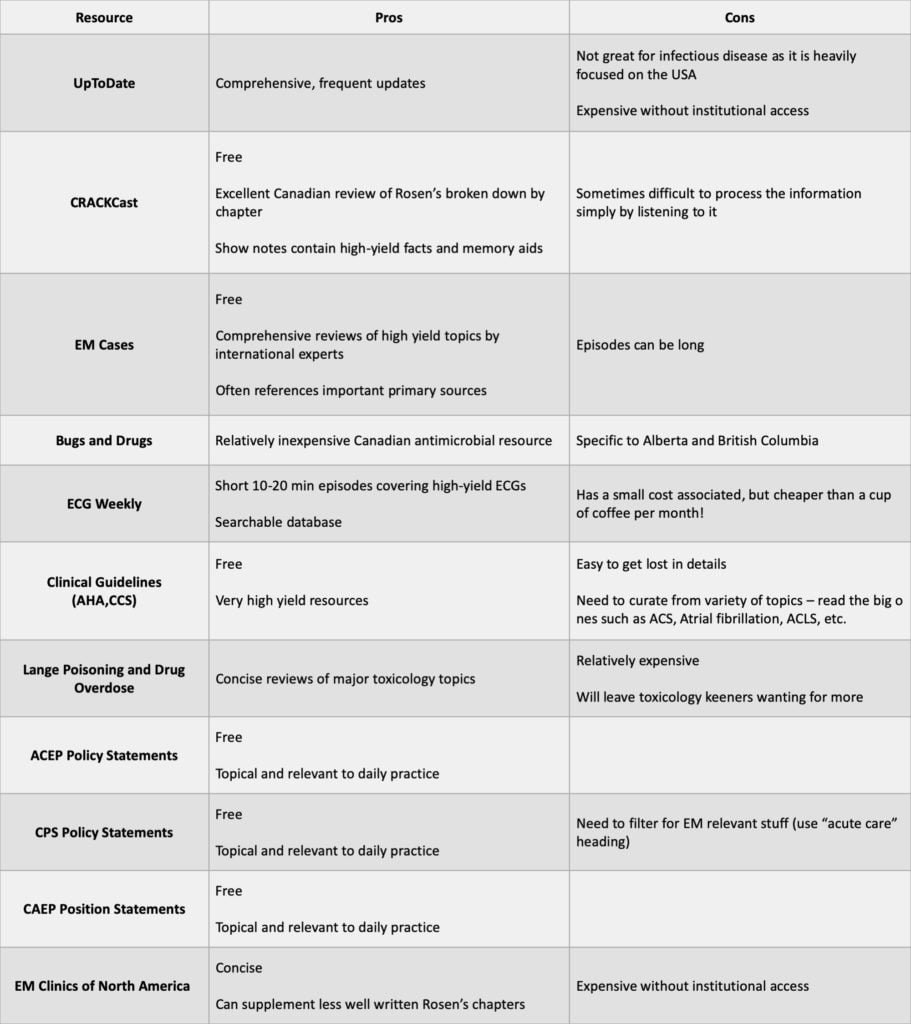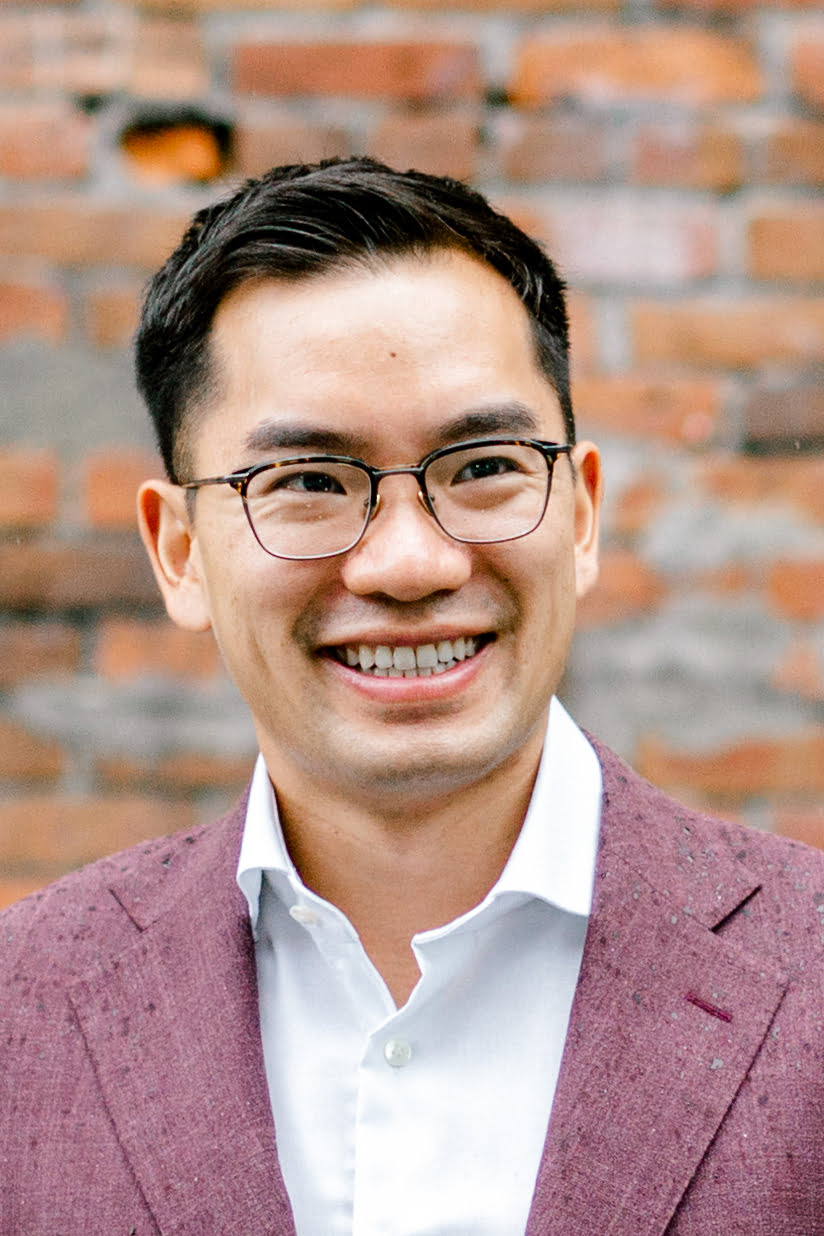For Royal College Emergency Medicine residents, the exam year is a grueling test of memory, resilience, and endurance. The year is shrouded in mystery, with relatively few articles sharing practical wisdom about how to survive and excel. As a group of five residents who trained at four sites across the country, we want to fill this gap by sharing five tips we wish we knew before this year.
We hope this will be a useful resource for our colleagues embarking on their exams, and a launching point for discussion. Please ask questions and share your insights!
1) There is no right way to study, but make it active!
Every individual and study group has their own way of studying, and the advice we receive from colleagues and mentors often conflicts. The common denominator is putting in the time and effort in a way that fits for you while trying to maximize active learning strategies such as spaced repetition1 and group review sessions.2
Different individuals have different preferences for study aids–mnemonics and categorizations of answers are helpful for some, but add a layer of complexity when you are trying to remember which mnemonic goes with which list. If you do use mnemonics, you may find that the most helpful ones are ones you make yourself. Use your own judgment but emphasize active learning strategies! Some find it beneficial to summarize diagnostic pathways or anatomic landmarks by physically drawing them out or taking brief notes. Here is an example of what this can look like if you find this strategy useful (Figure 1).

Do not be afraid to change strategies after starting if you realize that the strategy you have chosen is not working. We used many different core study strategies (Table 1). The strategies are listed primarily to show the variation across the country, rather than highlighting any preferred method. Other individuals who were successful in the exam have used significantly different strategies, including not reading Rosen’s (or skipping large portions) and not using Flashcards. Some have chosen not to use study groups, or to take advantage of online technologies to disrupt traditional in-person meetings.3 Online technologies may be particularly useful for those with childcare or eldercare responsibilities, since multi-hour studying sessions may not always be compatible with other parts of life.
For an excellent deep dive into the evidence behind active learning strategies check out EM Cases episode 111. It is well worth a listen, especially if you are just beginning your exam year!
Table 1: Examples of core study methods used by different training programs

2) Practice like you play
This is your year to become an expert in Emergency Medicine.
You likely won’t ever get another chance to spend so much time looking into the literature and filling in knowledge gaps. Focus your studying in a way that will be useful to you as an attending physician. Practically speaking, one example is using multiple resources to get answers to clinically important questions (Table 2), particularly when the Rosen’s chapter falls short. Some resources are accurate only within a particular population or location, such as antibiotic recommendations. We suggest using the regional resources you will be using as an attending, rather than memorizing a set of recommendations that is irrelevant to your real-life practice. There is room for this sort of variation on the exam, which allows for reasonable and safe practice variation.
Use clinical time to apply the textbook learning and refine your clinical approach. Remember to not lose the forest for the trees! Clinical time can be used as a break from studying, and as a time to get into the flow of working. Talk to patients, hold their hands: re-establish a connection back to the Emergency Medicine you love. Sometimes, you will need a reminder of why you are studying in the first place!
Table 2: Selected resources to answer clinical questions

3) Exam studying is a marathon, not a sprint.
Studying is a huge commitment throughout the year. Be upfront about your focus on the exam with extracurricular activities and projects, and many of us learned communication tips to politely decline opportunities (Table 3). We studied almost every day, including days where we had shifts, other academic commitments, or general life commitments. We spent a variable quantity of time each day on studying, between 2 and 6+ hours. Having said that, it is important to recognize how your body and mind work to optimize study quality. Some study better in the morning, others in the evening. Some prefer longer study sessions, while others do best with several shorter sessions. Make it a point to specifically schedule time off during the week. Most of us endeavored to do a non-studying activity like exercising or spending time with family each day. There is room in your study schedule to take time off for personal things like weddings and vacations. Many choose to take a vacation in a warm-weather place between January and March as a way to escape cold temperatures and recharge before the final few months of studying.
Get partners, family, and friends on board early and show them the process. Help them understand what the stakes are and why studying for the exam can become all-consuming. The more your family understands, the more they are able to be supportive. They are your allies in this! Friends and family are also a great resource when you need to put all the studying in perspective, take a short break, or even when you need someone to help run through a deck of flashcards.
Do not despair when things feel insurmountable. Accept that you will fall behind in your study schedule, and have perspective and self-compassion when this happens. You will find your stride and, as the year progresses, you will find some topics tend to come up multiple times, which lightens the load a bit. The volume of material is vast–it is not unusual to feel like nothing is coming together until right before the exam.
Table 3: Practical communication strategies that help to say “no.”4

4) It takes a village. Use your colleagues.
Take advantage of the great clinical teachers you have. On shift, find out who you are scheduled with and email them in advance; ask to be quizzed on difficult topics or request a practice oral exam before your shift. Take what is useful from your academic day seminars, and try to consolidate your study knowledge by participating in discussions and seizing the opportunity to ask content experts questions to clarify concepts.
Lean on your friends and colleagues from other specialties. Think about what you do in real life when you have a question about something that you’re not familiar with: you page the consultant! Do this when you have questions about study material, especially for topics we see less often, such as OBGYN, ENT and Dermatology.
Consolidate your clinical knowledge on off-service rotations. Take advantage of working with attending physicians with subspecialty training to synthesize your clinical knowledge and skills, fill in gaps and correct incorrect practice patterns from the past. Whether it is pediatric emergency medicine, sports medicine, or toxicology, it is never too late to ask questions. You will likely never have another opportunity to invest yourself solely in one area of emergency medicine.
5) Budget appropriately to reduce financial stress.
The board exam year is a very expensive process and you should budget for this to reduce unexpected financial stress during the year. In total, expect to spend over $12,000 for the exam and licensing. Here is a rough breakdown of some of the larger expenses during the year (Table 4).
Table 4: Financial costs associated with the Royal College Exam

*Remember to apply for your license early! When the exam is late in the year, you will need to submit required paperwork to the provincial college before you write your exam for it to be active on July 1.
Conclusion
The exam year is an exercise in endurance and mental grit. But, it is well worth it as you will come out the other side realizing that your knowledge base has grown substantially, you have consolidated that knowledge by filling in gaps you may not have known you had, and that you are ready for independent practice and a career of lifelong learning. Try not to compare yourself to everyone around you. Take some solace in the fact that there is significant variation in approach to studying even within this small sample of authors. Pace yourself, clear your plate as much as possible to focus on studying in a way that works for you, lean on those around you, and don’t lose sight of what keeps you well outside of medicine. You’ve got this!
Special thanks to Teresa Chan and Brent Thoma for their critical reading of this post!
For those writing the exam, which tips did you want more information on?
For those who have finished the exam, what are tips that resonated with you? What are ones we missed?
[bg_faq_start]Further reading on CanadiEM (click to expand)
Tips for EM Exams (T. Chan, R. Woods, C. Hicks, H. Murray, A. Sibley)
[bg_faq_end]References
- 1.Phillips JL, Heneka N, Bhattarai P, Fraser C, Shaw T. Effectiveness of the spaced education pedagogy for clinicians’ continuing professional development: a systematic review. Med Educ. May 2019. doi:10.1111/medu.13895
- 2.Hammar Chiriac E. Group work as an incentive for learning – students’ experiences of group work. Front Psychol. June 2014. doi:10.3389/fpsyg.2014.00558
- 3.Chan T, Sennik S, Zaki A, Trotter B. Studying with the cloud: the use of online Web-based resources to augment a traditional study group format. CJEM. March 2015:192-195. doi:10.2310/8000.2014.141425
- 4.Ting DK, Baylis J. From abstraction to action: Making wellness practical during residency training. CJEM. September 2018:662-664. doi:10.1017/cem.2018.445





